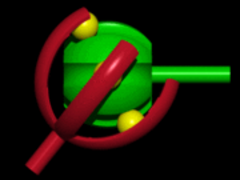Note relative positions of balls transmitting the torque couple,
[Edited on 22/1/08 by britishtrident]


Rescued attachment 180px-Simple_CV_Joint_animated.gif

Can anyone offer any opinions?
I'm trying to measure scrub radius on the car, I understand you take the point where he line of the king pin intersects with the ground but where
do you go frm here??
Is there such a thing as a negative scrub radius?
Thanks in advance!
quote:
Originally posted by Wingnut
Can anyone offer any opinions?
I'm trying to measure scrub radius on the car, I understand you take the point where he line of the king pin intersects with the ground but where do you go frm here??
Is there such a thing as a negative scrub radius?
Thanks in advance!
quote:
Originally posted by britishtrident
Some fwd use negative scrub radius to offset torqusteer.
No -- basic engineering mechanics - torque can't get "lost" by transmision along a shaft every action must have an equal and
oposite reaction.
[Edited on 22/1/08 by britishtrident]
CV joint
Note relative positions of balls transmitting the torque couple,
[Edited on 22/1/08 by britishtrident]


Rescued attachment 180px-Simple_CV_Joint_animated.gif
quote:
Originally posted by britishtrident
No -- basic engineering mechanics - torque can't get "lost" by transmision along a shaft every action must have an equal and oposite reaction.
[Edited on 22/1/08 by britishtrident]
quote:
Really just the distance from that point to the central point of the tyre contact patch.
quote:
Originally posted by Wingnut
quote:
Really just the distance from that point to the central point of the tyre contact patch.
I see, thank you. So is there a difference between the centre of the tyre & the centre of the contact patch??
Centre of the tyre seems easy to find but what about centre of the contact patch??
TIA!
quote:
Originally posted by CaptainJosh
quote:
Originally posted by britishtrident
An austin mini has almost equal length driveshafts and as a result has for intensive purposes, no torque steer- just to make a point.
On a completely flat smooth road with the steering straight ahead driven torque to each wheel will be absolutely equal but on vehicle with unequal length drive shafts such as an early base model MK1 Fiesta the driver will still experience torque steer.
Torque steer is a steering effect caused within the CV joint. The cause is the differences angle to the cv joint (when viewed in front elevation) of the two drive shafts.
It is easy enough to demonstrate in about a page of maths but life is too short.
Interestingly I didn't realise it until today that due to the nose rising under acceleration a FWD car with soft suspension will have more torque steer than a car with hard springs limited suspension tavel in droop.
Ians - 23/1/08 at 05:18 PMHaving just built a awd motorcycle engined hillclimb/sprint car where its design dictated the use of unequal length driveshafts I completely removed all the torque steer by using neg scrub offset and a nil droop front suspension . Ians